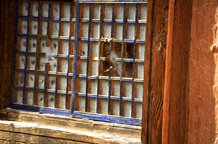click on small images to view full screen with caption
 |
| Uygen Rinpoche gazes from a high window of Palpung Monastery. |
From a high window I heard the sound of a child chanting sutras. The sound was distant, its source shielded behind massive log walls, its only outlet a small paper-covered lattice window that was usually closed. But in the still, rarefied air of the Tibetan plateau, the sound carried clearly to where I stood standing on a balcony listening. The voice was tremulous, breathy, a child struggling to use his undeveloped apparatus to do a job designed for a resonant bass. Then I heard a sudden clatter, and the chanting broke up into giggles. Patient, subdued tones from an adult soon rectified the situation, however, and the singsong began anew.
I heard the little Rinpoche's chanting long before I knew who he was. In the course of my work at Palpung Monastery, my perambulations often took me past the courtyard into which his quarters looked. Yet however much I peered at that mysterious window, I saw no more than a pair of eyes gazing with quiet watchfulness through a tiny square of glass. The eyes obviously belonged to a child, but not an ordinary one. This child resisted the impulses of ordinary 5-year-old boys: he never opened the sliding lattice to put his head outside, never flung anything to the flagstones below, never called to the monks who walked to and fro beneath his quarters. The little Rinpoche lived remote and aloof in his aerie, impervious to the outside world.
I had come to Palpung Monastery to assess damage from a recent earthquake, and to judge how the damage would affect plans to restore this little-known but spectacular monument. In the Tibetan capital of Lhasa, buildings like the Potala Palace have undergone extensive restoration, but out here in the hinterland Palpung has been utterly ignored. Thirty years of man's depredations and natural disasters had robbed Palpung of its splendor, stripped it of its gold embellishments on the outside and its inhabitants within, turning the once-mighty fortress into a bleak and empty shell.
Palpung escaped outright destruction--which was the fate of so many monasteries during China's Cultural Revolution--because the local government took it over, using the huge old building as a county seat. When China's policy toward religion relaxed during the 1980s, monks were allowed to return to Palpung. But the impoverished local government lacks funds to reverse decades of neglect, and Palpung's location--six hours' hike from the nearest motorable road--has rendered it all but forgotten. So my organization, the Los Angeles-based China Exploration & Research Society, has undertaken to restore this vast fortress, which is both an architectural treasure and the home of a most unusual small boy.
I did not know the dialect of this eastern part of Tibet, so Shiong-Shiong, a Tibetan engineer who was my co-worker, acted as my window to his world. He told me that the Rinpoche had been discovered last year on the grasslands not far away. Born to nomad parents, the child had been proclaimed to be the living reincarnation Uygen Rinpoche, one of the many holy men revered by Tibetans. From the moment of his discovery the boy's life changed completely. He and his family had been brought to Palpung, where he was receiving a first-class monastic education. And already, despite his tender years, he was reading and writing the complicated Tibetan script. Mastery of Buddhist philosophy will be his life's work.
On the final day of my stay at Palpung I was invited into the Rinpoche's presence. Wrapped in swaths of maroon cloth and yellow silk, he was tiny but regal as he sat cross-legged on a dais surrounded by the ritual tools of his Buddhist trade. The little Rinpoche with his fresh, rose-colored cheeks made a glowing contrast to the gloomy, soot-blackened chamber in which he lived. I sat down on the carpet before him, embarrassed not to know proper protocol for situations like this. Should I bow? The boy's two brothers stood by, looking sly and happy to see me--perhaps I was interrupting a boring routine. My discomfort soon melted away in the general glow that suffused the room. Smiling at me with an expression that lay somewhere between boying curiosity and fatherly kindness, the Rinpoche presented me with a silver spoon engraved with Tibetan designs--a token of thanks that I am helping to rebuild his monastery. I accepted it with two outstretched hands.
Whether or not you believe in reincarnation, there is something magical about this child. Supernaturally patient, cannily observant, poised and yet also innocent, he is Palpung's bright light for the future. It will be his leadership that will draw Buddhist scholars back to Palpung. And it's people, even more than restoration, that are vital to revive this venerable Tibetan monastery.